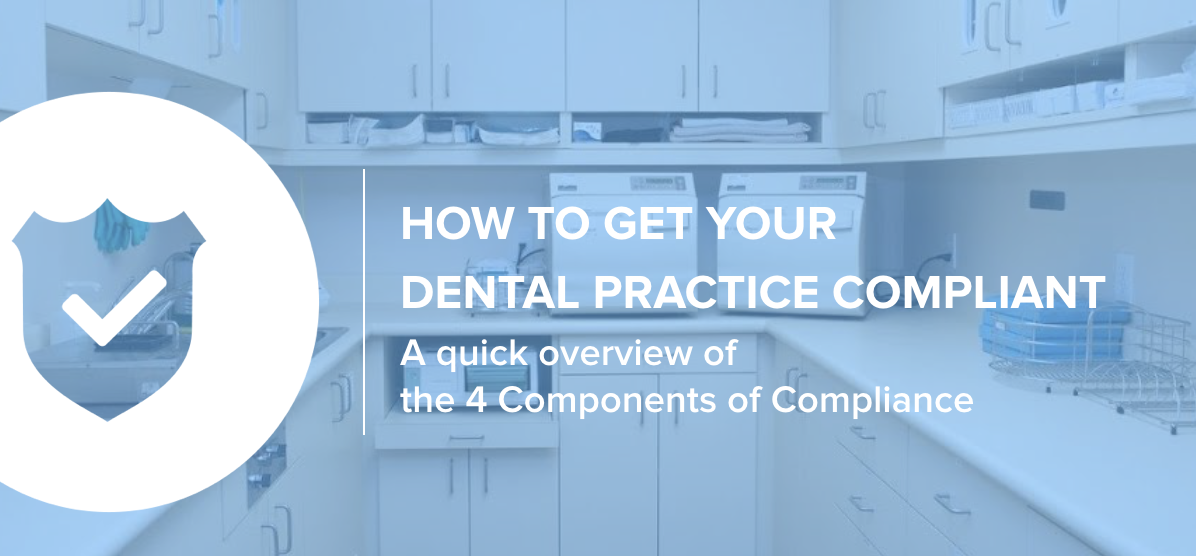November 2018. | Estimate reading time: 5-7 minutes
Is your practice compliant?
Infection control breaches should never ever be taken lightly. With most practices achieving an average of 77% compliance rate when audited, the risks are very real and concerning.
Dental practitioners are required to comply with either of the applicable Dental Board of Australia or Dental Council of New Zealand policies and guidelines. This includes ensuring mandatory infection prevention guidelines are fully implemented in your practice. This obligation cannot be delegated – responsibility to complete the task may be, but ultimately, the accountability remains with the clinicians.
Therefore, it is imperative that all clinicians are always familiar with all elements of infection prevention protocols required.
To help prompt you to see if your practice is compliant, here’s a quick overview checklist of what you must do/have to be compliant.
**It is important to note, that this guide is merely an overview outline of what it takes to be compliant. Each component includes subcomponents that attribute to the outcome of a practice being officially compliant.

[1] : Documentation
[2] : Validation of Sterilisation
[3] : Create & implement an Infection Control Management Plan (ICMP)
[4] : A Quality Assurance Program
[1] : Documentation
 Every practice must have the following documents in either hard copy or electronic form (includes guaranteed access), and all dental practitioners must have access to these documents.
Every practice must have the following documents in either hard copy or electronic form (includes guaranteed access), and all dental practitioners must have access to these documents.
Infection Prevention Policy & Procedure Manual
Your practice must have/ develop an infection control manual that includes detailed information about procedures specific to the daily routines at your practice. It provides a reference point for all members of the dental team and should also be used for training all dental staff.
This manual should be a comprehensive document that contains all your Infection Control policies and procedures that is aligned with current guidelines.
In addition to your practice’s Policy & Procedure Manual, there must be access to the following documents in your ‘IP library’ at the practice:
Australia
- The Australian Dental Association Guidelines for Infection Control – Third Edition
- The Australian Guidelines for the Prevention and Control of Infection in Healthcare published by the National Health and Medical Research Council (NHMRC)
- AS/NZS 4815:2006 Standards or the AS/NZS 4187:2014 Australian/New Zealand Standards
New Zealand
- Dental Council New Zealand – Infection Prevention & Control Practice Standard (May 2016)
- AS/NZS 4815:2006 Standards or the AS/NZS 4187:2014 Australian/New Zealand Standards
It is important to keep in mind that your manual and all associated documents should not live on bookcases gathering dust. Just having them does not constitute compliancy on this component.
Instead, a ‘well loved’ manual should constantly be reviewed, implemented and used in training, on-boarding new team members, regularly reviewed and regularly updated accordingly.
When updated, a Staff Register document should be signed by staff members to show they have understood, agreed and will ensure all protocols are adhered to.
[2] : Validation of sterilisation
 Validation is “a documented procedure for obtaining, recording and interpreting the results required to establish that a process will consistently yield a product complying with predetermined specifications”. Essentially, it is the recipe to produce the same result every time.
Validation is “a documented procedure for obtaining, recording and interpreting the results required to establish that a process will consistently yield a product complying with predetermined specifications”. Essentially, it is the recipe to produce the same result every time.
Because sterilisation is an entire process, not just a single event, all aspects of the process must be validated; not only the steriliser and the loads passing through it, but also the cleaning and packaging procedures prior to sterilisation, and the subsequent storage of sterilised items.
In order to ensure appropriate sterilisation of items in the surgery, your dental practice must thoroughly understand what a validated process means and how to fully implement a validation process.
This process can be outlined in four relevant steps:
- Step 1: Establish protocols and procedures
- Step 2: Determine the ‘cold spot’ in the sterilising chamber (Empty Chamber Study / Heat Distribution Pattern Test)
- Step 3: Validating the sterilising process
- Step 4: Implement a Quality Assurance program
To be compliant in this component, your validation process must show that sterilisation will repeatedly and consistently take place at a satisfactory standard when defined operating conditions are used.
[3]: Create & implement an Infection Control Management Plan (ICMP)

Each practice must also have an Infection Control Management Plan – a documented plan to prevent or minimise the risk of infection in relation to declared health services for everyone who has contact with your practice. This doesn't just include your patients, staff and team members, but also all other persons who have engaged or come in contact with your practice.
Your practice’s ICMP must detail out:
- The infection risks associated with the provision of dental treatments
- The measures to be taken to prevent or minimise the risk of infections
- How the operator is to monitor and review the implementation and effectiveness of those measures
- Details about the provision of training in relation to the ICMP for your entire team at your practice
- How often the ICMP is to be reviewed (this must be reviewed at intervals of not more than one year)
- The name of any person who is responsible for providing advice about and monitoring. The effectiveness of the ICMP.
Your ICMP should always be accessible to all staff members and also written in a way that is easily understood by everyone engaged at your practice.
[4] : A Quality Assurance Program
 Continuity of quality care can only be assured if all staff undertake and perform tasks in the same manner – thus it is an important aspect of successful infection prevention management to be performing regular assessment/audits to ensure that this is the case.
Continuity of quality care can only be assured if all staff undertake and perform tasks in the same manner – thus it is an important aspect of successful infection prevention management to be performing regular assessment/audits to ensure that this is the case.
A comprehensive quality assurance program should be implemented to support and demonstrate a “checking, proving and recording” methodology in your practice. Use a series of checks and balances to ensure the policies and protocols outlined in your practice manual are actually being implemented properly and accurately.
There’s a difference between “thinking” that your team is doing what they should be, and “knowing” that they are indefinitely doing so.
Choose and appoint an Infection Control Coordinator. Give them adequate training and support. Empower them to be successful in this expanded function their role.
Utilise an online self-assessment / audit tool; preferably one that formats a comprehensive Audit Report and provides recommended corrective actions for implementation as applicable where “semi” or “non-compliant” actions have been observed.
Alternatively, you could also use an existing Quality Assurance checklist and do so manually – just keep in mind that your manual checklist needs to address all aspects as outlined in your written policy and procedure manuals. Be sure to keep all completed Quality Assurance Reports on file to support internal audit processes and show documentation of any ongoing quality assurance programme.
As Compliance is an organic process, the four components mentioned above should always be reviewed regularly and updated.
Regulatory obligations state that dental practitioners must practice in a way that maintains and enhances public health and safety by minimising or preventing the risk of the spread of infectious disease. It is also required that each practice provides regular infection prevention training at least every 12 months.
Do not compromise on your own health and safety. Be able to reassure your patients, your team and your own self that you are safe. Get compliant now.
LET’S HAVE A CHAT: We understand that the process in getting compliant can be quite overwhelming and tedious, but you don’t have to go through it all on your own. Speak with our Prime Practice Compliance Team about any concerns or questions you might have.

